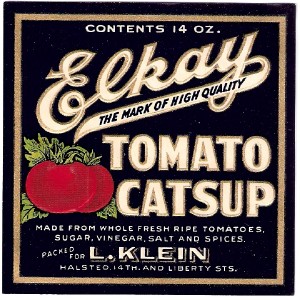I tried my hand at ketchup making for the first time this past week and the results were interesting. Two recipes: The first was one of the first recorded recipes for tomato catsup (yes, there are other kinds...more on that in a moment) from Mrs. Mary Randolf's The Virginia Housewife: Or, Methodical Cook.
TOMATO CATSUP.
GATHER a peck of tomatos, pick out the stems, and wash them; put them on the fire without water, sprinkle on a few spoonsful of salt, let them boil steadily an hour, stirring them frequently; strain them through a colander, and then through a sieve; put the liquid on the fire with half a pint of chopped onions, half a quarter of an ounce of mace broke into small pieces; and if not sufficiently salt, add a little more--one table-spoonful of whole black pepper; boil all together until just enough to fill two bottles; cork it tight. Make it in August, in dry weather.
The result is a very simple sauce: tomatoes, salt, and spices. Since there was no acidity or vinegar, just high salt, I didn't bottle it, but am keeping it in the fridge. Even after a long-ish cooking it has a fresh flavor, and is going to be a nice way to brighten soups or stews. It raised an important question, though...a high salt, low oxygen environment leads to fermentation, like sauerkraut or kimchee--is that the reason for the original long-necked catsup bottles? Lo and behold! It would seem that even in the simple recipes there's an expectation left assumed. No wonder Mrs. Randolf said it should be made "...in August, in dry weather". My smaller bottle of this one is going to become an experiment.
So what about my more "modern" recipe from the NY Times? Much more spicy and tangy, much more what I'd expect from a catsup...but not as bright because of the apples and onions. Next time around I'll cook it down a bit more, make it thicker, but it's tasty as is, and great on hot dogs and burgers, if slightly prone to soak into the bun.
 |
| The two types side-by-side: 1826 recipe on the right. |
 For more information on the history of catsup The Nibble has done an engaging multi-part article which is more entertaining and through then I ever could be, including some very interesting information on walnut, mushroom, cranberry, plum, and banana catsups, and product reviews for current store brands.
For more information on the history of catsup The Nibble has done an engaging multi-part article which is more entertaining and through then I ever could be, including some very interesting information on walnut, mushroom, cranberry, plum, and banana catsups, and product reviews for current store brands. For a Paleo blogger take, look here.
And for more information on strange and unusual catsups, allfoodsnatural.com has a fascinating and exhaustive list.




0 comments:
Post a Comment